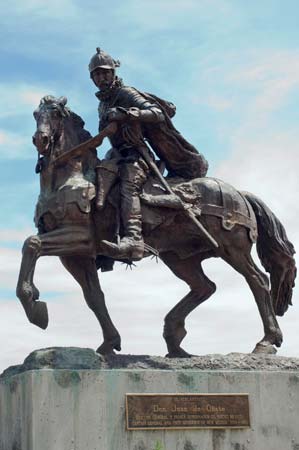Don Juan de Oñate (1550 - 3 June 1626), sometimes referred to as "The Last Conquistador," was born in colonial Mexico, also known as New Spain. One of the interesting Don Juan de Oñate facts about his family was his father, Cristobal de Onate, who was a Spanish Conquistador and wealthy resident of the colony.
Oñate would lead expeditions to The Great Plains, the Colorado River, and the Southwest of America. He would eventually found the city of Santa Fe.
Jump to:
Early Life

Don Juan de Oñate was born in New Spain around November 1550 and was the son of a wealthy conquistador. He grew up learning the tactics of Spanish Warfare and the stories of many of the conquests.
Being born in colonial Mexico meant that he would have had much knowledge of some of the early Conquistadors such as Hernan Cortes, Francisco Pizarro, Hernando de Soto, Juan Ponce de Leon, Vasco Nunez de Balboa, Francisco Coronado, and of course the great Christopher Columbus.
Don Juan de Oñate married Isabel de Tolosa Cortes de Moctezuma, granddaughter of Hernan Cortes and the great-granddaughter of the Aztec Emperor Moctezuma Xocoyotzin.
Don Juan de Oñate quickly rose to prominence through his name, marriage, and ability. He was handpicked to organize the resources from newly acquired territories and was given three objectives:
- Explore the newly acquired territory (modern New Mexico)
- Capture the Spanish traitor
- Spread Christianity by building missions
Expedition to the Great Plains
The newly acquired territory that Oñate set up to explore was the Great Plains, and was inherited by the Pueblo Indians. When he arrived at the territory of the Pueblo people, he entered into communications with them.
These communications included trade that would help the Spanish with their expedition. However, the Pueblo people resisted the trade due to winter coming and their need to spare their own resources. Oñate responded with a demand to give them the resources, and resulted in 11 Spaniards being killed, including Oñate's nephew.
In January 1599, Oñate retaliated for the loss of his nephew by sending Juan's brother, Vicente de Zaldivar, on an offensive known as the Battle of Acoma Pueblo. The retaliatory strike killed hundreds and ended with the capture of about 500 villagers, mostly women and children. The captives were put on trial, found guilty, and sentenced by Oñate. All men and women older than 12 were to be enslaved for 20 years. In addition, men older than 25 (24 individuals) had one foot amputated.
These actions gave Juan de Oñate the reputation of brutal and dangerous.
After his dealings with the Pueblo peoples, Oñate traveled east and renewed Francisco Coronado's search for the fictitious city of gold. He traveled along with the Canadian River and into modern-day Oklahoma, where he ran into the Apache people.
Don Juan de Onate Facts: Escanjaques and Rayados
Juan de Oñate continued until he came upon a group of natives that were called the Escanjaques. The Escanjaques were a tribe of hunters that lived off the buffalo. Oñate noted that they were dressed in buffalo skins, and they did not plant any crops. When they spoke to Oñate, they referenced an enemy tribe called the Rayados and volunteered to guide them to their village. Oñate described the Escanjaques village as having close to 5,000 people living in 600 houses.
When Oñate came upon the Rayados, he was impressed with their society. They were well-organized, friendly, willing to trade, knew the landscape, and showed respect to their leader. After meeting the Rayados, Onate developed a great deal of respect for them, even more than the Escanjaques. He spoke with their tribe leader, Caratax, and was impressed with him as well.
Caratax was detained by Oñate but was treated very well for his services as a guide. Oñate came upon an abandoned village of the Rayados people and had to restrain the Escanjaques people from pillaging it. Afterward, he sent the Escanjaques and learned of possible military action by the Rayados people. Outmanned and not wanting to cause any more conflict, Oñate decided to head back to New Mexico.
Oñate had worried about the Rayados hurting or attacking his expedition party, but it was instead the Escanjaques who repelled his men on their return to New Mexico. Oñate described a pitched battle with 1,500 Escanjaques, probably an exaggeration, but many Spaniards were wounded and many natives killed.
After more than two hours of fighting, Oñate himself retired from the battlefield. The hostage Rayado chief Caratax was freed by a raid on Oñate, and Oñate freed several women captives, but he retained several boys at the request of the Spanish priests for instruction in the Catholic faith.
Later Years
Oñate went on to found the colony of Sante Fe, but just before he could settle in, he was recalled to Mexico in 1606, where he stood trial for his brutal act. He was found guilty but appealed, and the charges were dropped. He eventually made it to Spain, where the king appointed him head of all mining inspectors of Spain.
Don Juan de Oñate's expeditions set the stage for Spanish expansion into the southwestern portion of modern-day America with the founding of Santa Fe.
Don Juan de Oñate lived to an older age, considering the average age of a Conquistador. He died at the age of 76 on June 3, 1626, in Guadalcanal, Seville, Spain.
Don Juan de Onate Facts: Online Resources
- Wikipedia - Juan de Oñate
- The Pirate King - Juan de Oñate
- New Mexico History - Don Juan de Oñate
- Youtube - Controversy of Don Juan de Oñate's Statue Part 1
- Youtube - Controversy of Don Juan de Oñate's Statue Part 2
- The History Junkie's Guide to Spanish Conquistadors
- The History Junkie's Guide to Famous Explorers
- The History Junkie's Guide to Colonial America
- The History Junkie's Guide to the American Revolutionary War
